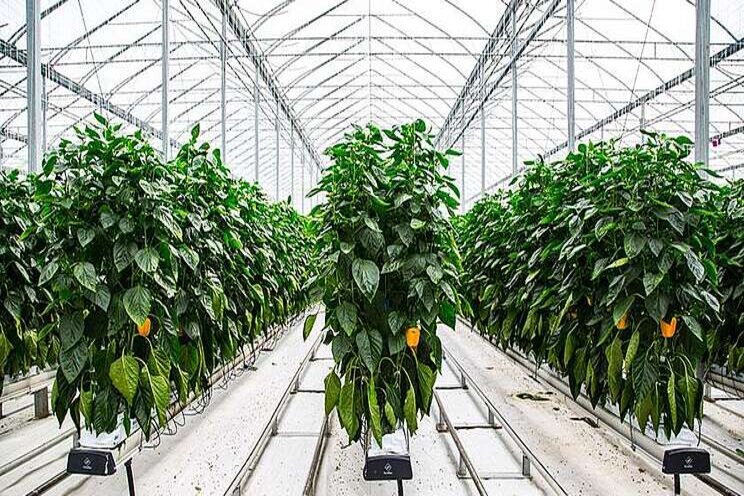COVID-19 adds stress but optimism still reigns
Added on 28 February 2021

"I would say that this past year has been incredibly difficult for us," said Joseph Sbrocchi, general manager of Ontario Greenhouse Vegetable Growers.
"The health and well-being of our workers is absolutely key, because they're that important to the whole show, and we continue to be very, very careful, and try to ensure that we do everything possible to make sure that their health is protected."
As the Ontario greenhouse vegetable harvest season accelerates, greenhouse workers are soon expected to receive vaccines, having been given priority by the government of Canada as essential workers.
Despite the challenges brought by COVID-19, industry leaders are optimistic about future growth.
The coronavirus brought labor challenges to growers, but the industry saw a few silver linings in the adjustments it made during the pandemic. Greater efforts at communication paid off for some.
"We have discovered that virtual meetings have had a positive affect on our company," said Jim DiMenna, president of Red Sun Farms, Kingsville, Ontario.
Stature
Ontario accounted for about 70% of Canada's greenhouse vegetable acreage in 2018, according to Statistics Canada, and the acreage under glass in Ontario grew 27% from 2014-18.
The total value of Canada's greenhouse vegetable exports grew 37% from 2014-18, with greenhouse tomato exports growing 24%, peppers up 31% and cucumbers rising 73%.
By share of Canadian greenhouse vegetable export value, tomatoes accounted for 37%, peppers 35% and cucumbers 28%, according to Statistics Canada.
The current number of greenhouse farms in Ontario is close to about 225, Sbrocchi said.
"The numbers are pretty stable in terms of the actual number of farms," he said, noting some operations have moved in and out of cannabis. The number of acres under glass has grown, he said, and there has been some consolidation of production capacity among growers.
Sbrocchi said the number of tomato, pepper and cucumber acres under glass is 3,400 to 3,500. That doesn't include greenhouse capacity devoted to strawberries or lettuce, which are two commodities that are gaining momentum.
From large to small, there are about 20 registered marketers of Ontario greenhouse vegetables, he said.
Season
Canadian greenhouse vegetables are shipped every month of the year. U.S. imports of Canadian cucumbers occur in every month, but peak supplies run March through October.
U.S. imports of Canadian tomatoes accelerate in April and peak from May through August.
Canadian pepper shipments to the U.S. gain speed in April and peak from May through October.
Sbrocchi said that although growers are investing in supplemental lightl technology to extend the growing season, the transition is ongoing and production is still much lighter in the winter.
"A plant will produce the most with 16 or 17 hours of daylight, so supplemental lighting is designed to help to trick the plants into thinking that they are getting 16 to 17 hours of daylight," Sbrocchi said.
All the new acreage that's come on in the past three or four years has had lights, he said.
Future growth
Sbrocchi thinks there is room for continued growth for Ontario greenhouse growers.
"I think, to be honest with you, the greenhouse businesses all over North America have plenty of room for expansion," he said.
With the popularity of berries and lettuce increasing, Sbrocchi said there may growth in the variety of produce commodities grown in greenhouses.
"Automation is coming and will certainly be very much relevant in the next five years," he said.
There is a fair amount of automation in greenhouses now, and there is investment in moving greenhouses to a more automated state, he said. But tasks such as tending the plants and harvesting are still largely handled by workers.
"We are continually growing greenhouse production and the need for workers is not necessarily going to decrease, because you've got more acres," he said.
DiMenna said trends favor healthy and safe food and the continued expansion of protected agriculture in the coming years.
There is big opportunity in bite-size snack products in the years ahead, said Mark Slater, owner of Erie James Ltd., Leamington.
Erie James grows European cucumbers, mini cucumbers, beefsteak tomatoes, tomatoes-on-the-vine, colored bell peppers, mini sweet peppers, grape tomatoes, medley tomatoes and eggplant.
Slater anticipates steady, controlled growth for the company in the next five years as output increases to meet demand.
"As consumers become more savvy about the value proposition of a greenhouse-grown vegetable, we will continue to see growth in recognition and consumption," said Chris Veillon, chief marketing officer for Pure Hothouse Foods, which markets under the Pure Flavor brand.
"Greenhouse-grown vegetables have been very impactful for the overall consumption of fresh vegetables."
Veillon said future growth will come with crops that can be grown all year round. Pure Flavor already produces tomatoes and cucumbers year-round, and others in the greenhouse sector are producing strawberries year-round.
"Bell pepper crops are starting to use different lighting types/spectrums to be able togrow through the winter," he said.
"As time moves forward you will see more and more Ontario growers investing and transitioning to year-round production to meet the surging demand."
Over the next five years, some marketers estimate steady and controlled growth of Ontario greenhouse vegetables, with output in five years perhaps 10% or more higher than today.
Veillon estimated that Pure Flavor's greenhouse production in Ontario will grow more than 20% over the next five years.
Organic acreage in Leamington could range from 6% to 10% of total area, industry leaders estimate, and organic area under glass is growing faster than conventional production.
Pepper photo, courtesy Pure Hothouse Foods
Source: The Packer
Source: The Packer
More news















